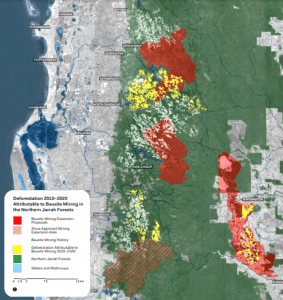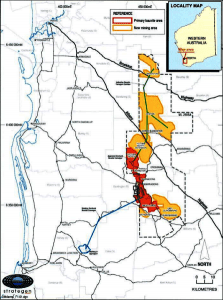
A new report, “A thousand cuts”, released on 3 May 2022 by WA’s peak environment and forest conservation groups provides valuable new information and analysis to the public about the impacts of bauxite mining in the Northern Jarrah Forests of the Darling Range. This comes amidst growing community alarm raised by proposed major expansions in close proximity to Jarrahdale and Dwellingup.
The report points to bauxite mining as the primary cause of deforestation in Western Australia’s South West forests; there has been more land cleared for bauxite mining than by the timber industry in the South West over the past decade. About 62% of the 18,000 hectares of medium-tall forests in WA deforested from 2010 to 2020 were to allow for mining.
The report also notes that most of the forest between Collie and Armadale is expected to be fragmented by bauxite mining by 2060 and focuses in particular on the current Alcoa expansion proposals. However, it is important the community is also aware that bauxite mining leases covering the Northern Jarrah Forests extend another 30km northeast of Armadale; all state forest areas as far north as Mundaring are vulnerable to future mining expansions within the Alcoa and South32 leases which cover a total area of almost 10,000 sq km.

In the near-term, South32 expansions will be focused on exploiting bauxite reserves near Boddington (see Map 5 on p.14 of the report). However, the company’s expansion plan, environmentally approved in 2008, indicated that, like Alcoa, it also intends to mine larger areas of the Northern Jarrah Forests (including wandoo woodlands), to 60km northward of the Boddington area (to north of Brookton Highway). That mining contribution to the overall fragmentation and loss of mature jarrah forest and wandoo woodlands will be substantial (see map on left). But those expansions will be more remote from regional centres; and perhaps because of that the South32 plans appear to have progressed ‘under-the-radar’ of the wider community.
In parallel with the release of “The Thousand Cuts” report, the WA branch of Forestry Australia (the professional body that represents the views of forest managers and scientists) has in a recent statement also summarised its own great concerns about bauxite mining and revegetation in the Northern Jarrah Forest .
Key recommendations of the “Thousand Cuts” report and the aims of the Forestry Australia statement respectively include, in part:
“A thousand cuts” report (p.48) recommendations (in part):
- Recommendation 1 – That no further clearing or fragmentation of native forest in the Northern Jarrah Forest for mining be authorised.
- Recommendation 2 – That the Environmental Protection Agency undertake a strategic assessment of the potential cumulative impacts of past, current and proposed activities and developments on the Northern Jarrah Forest.
- Recommendation 5 – That the WA government immediately make up-to-date consolidated versions of all State Agreements publicly available.
Forestry Australia statement (p.7) aims (in part):
- Aim 2 – Recommend that management of the mined areas be covered in the Forest Management Plan so that the environmental and financial consequences of bauxite mining are identified as a State responsibility and addressed appropriately. Effectively managing the legacy of bauxite mining will require resourcing in perpetuity.
- Aim 3 – To present the case that the impacts of bauxite mining operations on forest ecosystems and the lack of large reserve areas in the high-rainfall, high-quality northern jarrah forest need to be addressed as part of the current review of the Forest Management Plan by the Conservation and Parks Commission.
- Aim 4 – To propose that the lack of adequate reserve areas in the high-rainfall, high-quality northern jarrah forest within the mining envelopes be addressed by the current review of the Regional Forest Agreement being conducted by State and Federal departments.
- Aim 5 – To present the case that Alcoa and South32 should be required to thin rehabilitated forests prior to their return to management by the State.
HikeWest supports the above recommendations/aims (and others) of both the “Thousand cuts” report and the Forestry Australia statement.
Also see:
- “A thousand cuts – Mining in the Northern Jarrah Forests” – Project NJF (WA Forest Alliance, Wilderness Society, CCWA), 2022.
- “Statement on Bauxite Mining and Revegetation in the Northern Jarrah Forest” – Forestry Australia, February 2022.
- “Worsley Alumina Project Expansion- Environmental Review and Management Programme –Executive Summary” – Strategen for Worsley Alumina Pty Ltd, May 2005.
- “Bauxite mining” – HikeWest, page on this website.
(Posted 8 May 2022.)
View more news updates